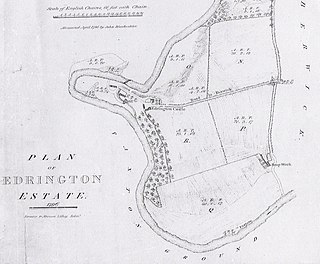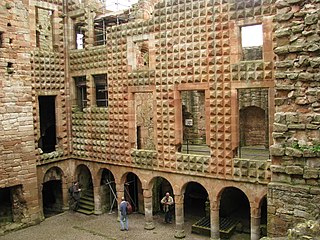Related Research Articles

Hermitage Castle is a semi-ruined castle in the border region of Scotland. It is under the care of Historic Scotland. The castle has a reputation, both from its history and its appearance, as one of the most sinister and atmospheric castles in Scotland.
Patrick Hepburn, 1st Earl of Bothwell was Lord High Admiral of Scotland. He rose to political prominence after supporting James IV against his father, and was proxy at the King's marriage.
Adam Hepburn, Master of Hailes was Sheriff of Berwickshire in April 1467, and had a charter of confirmation of Dunsyre in the sheriffdom of Lanarkshire, dated 13 October 1475, being thereafter designated 'of Dunsyre'.
Sir Robert Lauder of the Bass was a Scottish knight, armiger, and Governor of the Castle at Berwick-upon-Tweed. He was also a member of the old Scottish Parliament. The Lauders held the feudal barony of The Bass, East Lothian, Edrington Castle and lands in the parish of Mordington, Berwickshire, Tyninghame in Haddingtonshire, and numerous other estates and properties elsewhere in Scotland.

Crichton Castle is a ruined castle near the village of Crichton in Midlothian, Scotland. It is situated at the head of the River Tyne, 2 miles (3.2 km) south of the village of Pathhead, and the same distance east of Gorebridge.

Hailes Castle is a mainly 14th century castle about a mile and a half south-west of East Linton, East Lothian, Scotland. This castle, which has a fine riverside setting, belonged to the Hepburn family during the most important centuries of its existence. Since 1926, it has been the subject of a state-sponsored guardianship agreement, which is now under the auspices of Historic Environment Scotland as a scheduled monument.

Edrington is a medieval estate occupying the lower part of Mordington parish in Berwickshire, Scottish Borders, Scotland, five miles (8.0 km) west of Berwick-upon-Tweed. From probably the 14th century, if not earlier, a castle occupied the steep hill above the mill of the same name on the Whiteadder Water. The castle ruin is still marked on today's Ordnance Survey maps, and still appears in locality references in The Berwickshire News. The principal farm of the estate is Edrington Mains.

Morham, East Lothian, sometimes spelt Moram, Morum, or Morhame in old records, is the smallest (agricultural) parish in Scotland, sandwiched between five other parishes: Haddington, Garvald, Yester, Whittingehame, and Prestonkirk, in the undulating lower reaches of the Lammermuir Hills.
Sir Alexander Home of that Ilk, 1st Lord Home was in 1448 Sheriff Deputy for Berwickshire, and was made a Lord of Parliament on 2 August 1473. He is an ancestor of the Earls of Home.
Robert Lauder of The Bass was an important noble in Haddingtonshire, the Merse, and Fife. Stodart remarks that "to 1600 the barons of the Bass sat in almost every parliament". He was a firm supporter of Mary, Queen of Scots whom he accompanied to Carberry Hill on 14 June 1567, and fought for at the battle of Langside.
Sir Robert Lauder of Popill was a Scottish landowner and an adherent of Mary, Queen of Scots.
Sir Patrick Hepburn of Waughton and Luffness was a Scottish laird and notable Covenanter from East Lothian. In 1639-1641 Sir Patrick was a member for Haddingtonshire in the Scottish Parliament.

The Lord of Liddesdale was a magnate in the medieval Kingdom of Scotland; the territorial lordship of Liddesdale was first created by David I of Scotland, perhaps between 1113 and 1124 when the latter was Prince of the Cumbrians. From an early period the caput of the lordship was Hermitage Castle, the strength of Liddesdale. King David gave the territory to Ranulf de Soules, a knight from the Cotentin Peninsula. It was forfeited by the Soulis family in the 14th century and eventually passed to the Douglases, only to be lost to the Hepburns by order of James IV. Archibald Douglas, 5th Earl of Angus was remunerated for this loss by the lordship of Bothwell Castle, although the Hepburn Earls of Bothwell retained the territorial designation
George de Dunbar, 11th Earl of Dunbar & March 13th Lord of Annandale and Lord of the Isle of Man, was the last of his family to hold these titles.
Sir Robert de Lawedre (Lauder) of Edrington & The Bass, Knt., was a Burgess of Edinburgh and a confidant of King Robert III and sometime Guardian of his son, the future James I of Scotland.

Francis Stewart, 5th Earl of Bothwell was Commendator of Kelso Abbey and Coldingham Priory, a Privy Counsellor and Lord High Admiral of Scotland. He was a notorious conspirator, who led several uprisings against King James VI and died in poverty, in Italy, after being banished from Scotland. Francis was the first cousin of King James VI of Scotland. Francis's maternal uncle James Hepburn, 4th Earl of Bothwell was the chief suspect in the murder of James VI's father Henry Stuart, Lord Darnley.
The Lordship and Barony of Hailes is a Scottish feudal lordship.
Hailes may refer to:
George Haliburton, 4th Lord Haliburton of Dirleton, was a Scottish Lord of Parliament.
The feudal barony of Dirleton was a feudal barony with its caput baroniae originally at Castle Tarbet, Elbottle Castle and later at Dirleton Castle in East Lothian, Scotland. The Lordship & Barony of Dirleton lay in East Lothian a few miles west of North Berwick, the land comprising the Caput of the Barony is today only a little over 40 acres, including the Island of Lamb, North and South Dogs in the east coast of Scotland. Its ruined castle, two triangular greens and the buildings are grouped in the traditional style of a medieval township. Dirleton Castle was built in the middle of the twelfth century by a branch of the Anglo-Norman family of De Vaux, a family with its origins in Rouen, Normandy, which had settled in Dirleton during the reign of King Malcolm IV (1153‒1165). The original castle was modelled on contemporary French castles, in particular Coucy la Chateaux north of Paris. Dirleton Castle was defended against the invading army of Edward I of England in June 1298, but eventually fell to Anthony Beck, the fighting Bishop of Durham. In 1311 the castle was recaptured by the Scots and Robert the Bruce ordered that it be reduced (ruined) to eliminate the possibility of it being occupied by the English in the future. Dirleton was in the hands of the De Vaux family for about two centuries.
References
- The Scots Peerage by Sir James Balfour Paul, Edinburgh, 1905, 'Bothwell' p. 141/2.
- ↑ Macdougall, Norman, James III John Donald (1982), p. 329 index, has the grandson as the last captain.